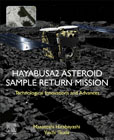
Hayabusa2 Asteroid Sample Return Mission: Technological Innovation and Advances
Hirabayashi, Masatoshi
Hayabusa2 Asteroid Sample Return Mission: Technological Innovation and Advances covers the second Japanese asteroid sample return mission. The purpose of the mission is to survey the asteroid Ryugu's surface features, touch down on the asteroid, form an artificial crater by shooting an impactor, and collect sample materials. This book covers these operations, along with everything known about key technologies, hardware and ground systems upon Hayabusa2's return to Earth in 2020. This book is the definitive reference on the mission and provides space and planetary scientists with information on established technologies to further advance the knowledge and technologies in future space exploration missions. Broadly and comprehensively covers technologies necessary for space exploration missions Provides a unique focus on small body exploration missions Covers landing and impact experiments during the proximity operations of Hayabusa2 INDICE: 1. Introduction Tsuda, M. Yoshikawa, Hirabayashi, Kikuchi Summary of this book2. Mission objectives Tsuda, M. Yoshikawa 3. Cruise and approach phases Tsuda, Saiki 4. Asteroid-proximity phase Tsuda, Saiki 5. Re-entry phase Tsuda, Saiki, Nakazawa Including the collection of the sample capsule6. Operation planning and execution 6 Station-keeping (HPNAV) Takei, Keep the spacecraft at the home position.7. Controlled descent (GCP-NAV) Ono, Ogawa Descent for special operations. Ground Control Point Navigation8. Observation campaign Takei, Operations for Box-A, B, C, Mid-alt, DO, CRA1, 2.9. TD (6DoF control) Terui Touchdown planning and results10. TMT Ogawa Image processing 11. MASCOT Mimasu Separation of MASCOT, and interface between JAXA and DLR/CNES12. MINERVA-II-1, 2 K. Yoshikawa, van Wal. MINERVA-II-1 separation operation and landing site operation13. SCI Saiki, Mimasu 14. Solar conjunction phase Soldini 15. Fault management Takei, 16. Spacecraft dynamics, orbit determination, and trajectory design 16 Gravity/Radiometric science Ikeda, Takeuchi Gravity measurement17. IES trajectory design Tsuda Low-thrust trajectory design and approach trajectory design18. Orbit determination Takeuchi Orbit determination during Regular and Special Operation; Optical Navigation Phase, DDOR. 19. Contact dynamics K. Yoshikawa Spacecraft dynamics during the touchdown operation, especially during the contact.20. MINERVA/TM orbit design Ooki, K. Yoshikawa, Ikeda Orbit design for MINERVA-II-2, and its dynamics21. Quasi-periodic orbit Kikuchi Searching for orbits that the spacecraft can stay around the body. Hardware systems developments22. Sampler Sawada, K. Yoshikawa 23. IES Nishiyama, Hosoda, Tsukizaki Ion Engine System24. Power system Shimada 25. Thermal design Nakazawa Thermal design and analysis; thermal analysis for the touchdown operation26. AOCS AOCS 27. Communication subsystem Toda, Takei 28. RCS Mori 29. LIDAR, LRF Terui 30. CAM-H, DCAM Sawada 31. Sample-return capsule Yamada, Nakazawa Return capsule design32. Ground station Fujii, Takeuchi Communication operation using the Usuda station and DSN. 33. HIL (operation training) Takei Operation training34. Data archive (SPICE) Yamamoto Hayabusa2 mission and beyond35. Outreach activity M. Yoshikawa 36. Industrial effort NEC 37. Extended mission Mimasu, Hirabayashi, at al Extended mission of the Hayabusa2 mission
- ISBN: 978-0-323-99731-7
- Editorial: Elsevier
- Encuadernacion: Rústica
- Páginas: 448
- Fecha Publicación: 15/04/2022
- Nº Volúmenes: 1
- Idioma: Inglés
